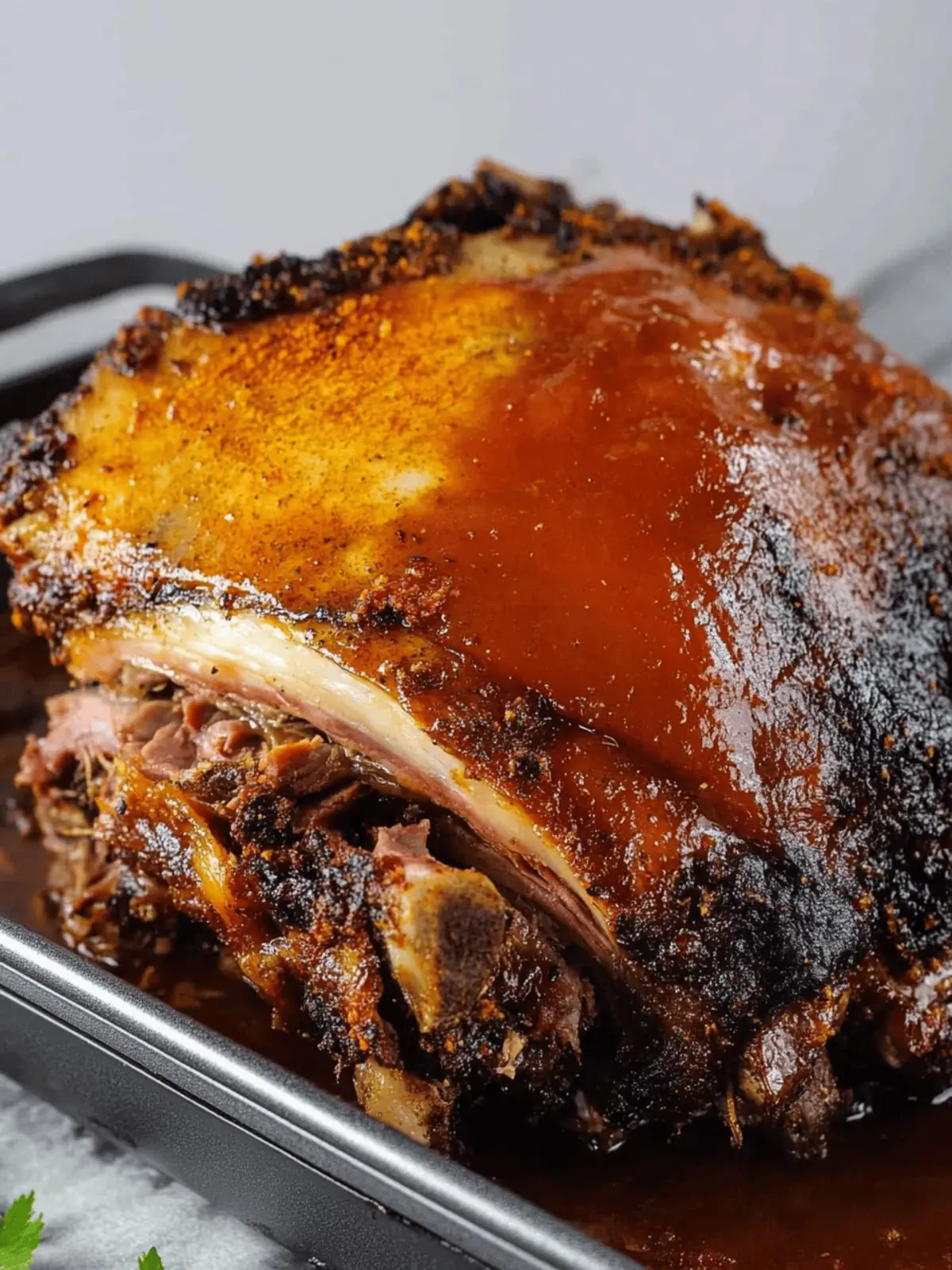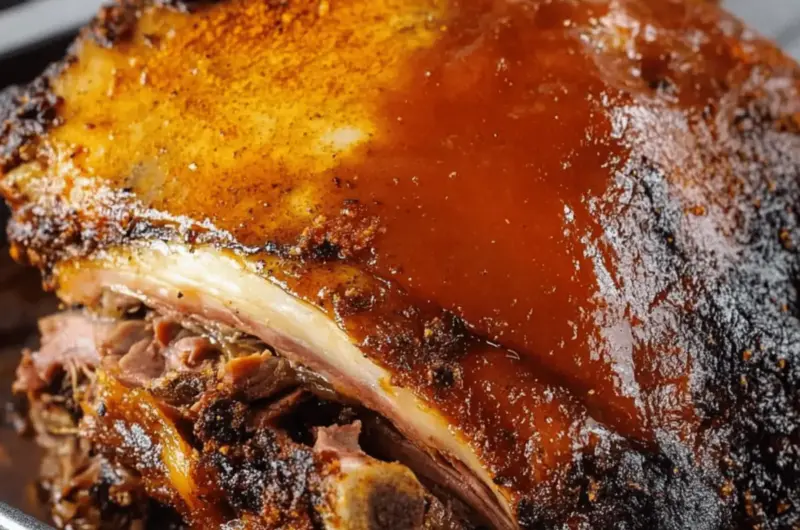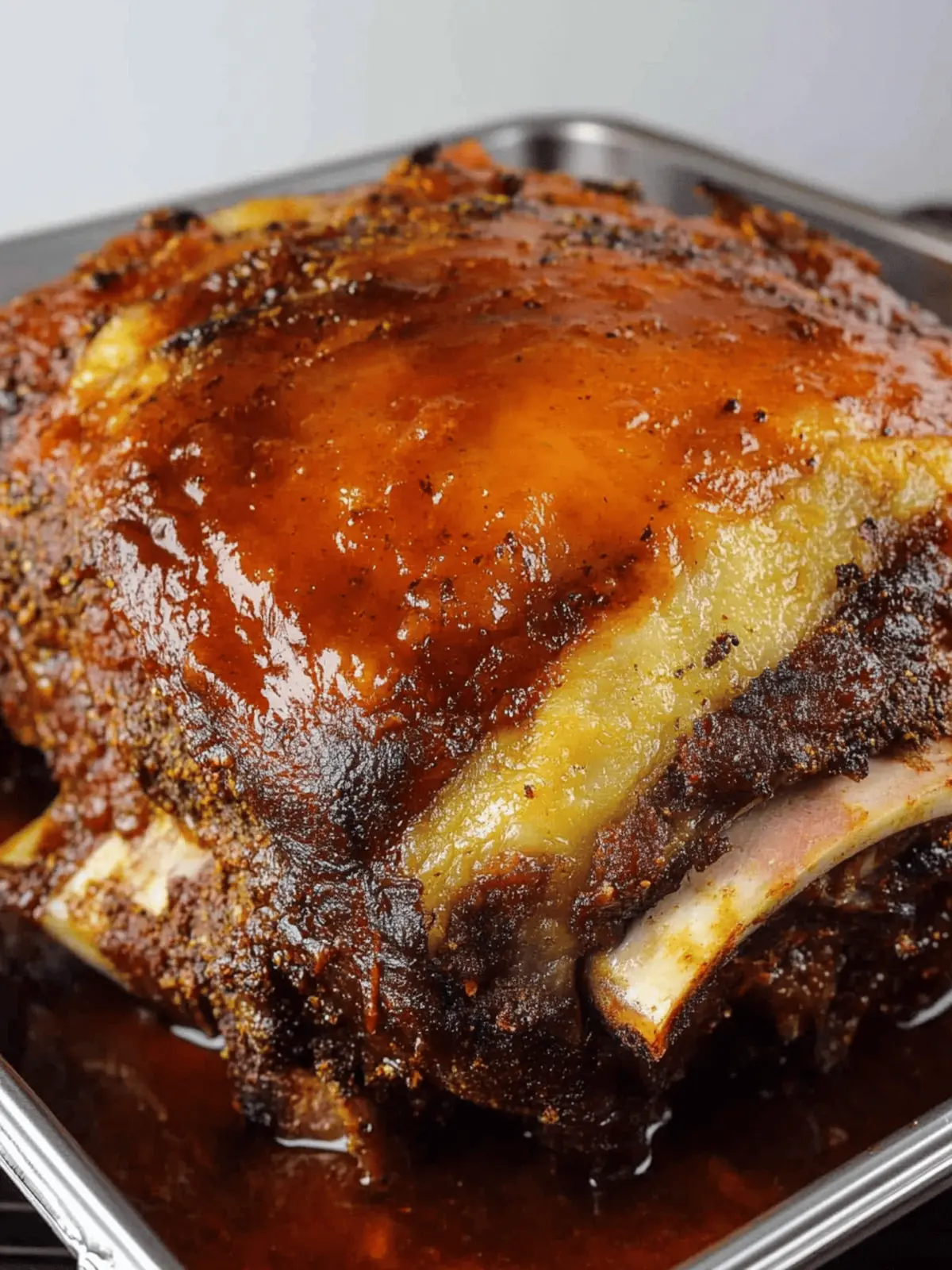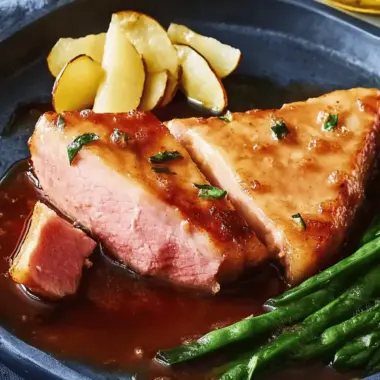Picture this: the rich scent of garlic and spices filling your kitchen as you prepare for a feast that celebrates culture and flavor. There’s something truly magical about making Pernil, the Puerto Rican slow-roasted pork shoulder that has become a staple for gatherings and special occasions.
The joy of creating this dish lies in the anticipation—you can almost hear the crackle of the skin and feel the tender meat waiting to be shredded. After a long day, I often find solace in this recipe, as the slow roasting transforms an unassuming pork shoulder into an irresistible centerpiece.
A delightful blend of adobo seasoning, oregano, and cumin coats each inch of flesh, promising a depth of flavor that dances on your palate. Whether it’s a holiday gathering or just a delicious Sunday dinner, Pernil is sure to impress your friends and family, elevating home-cooked meals to an extraordinary level. Join me as we embark on this culinary adventure and discover how to turn a simple cut of meat into a show-stopping dish!
Why is Pernil a must-try recipe?
Irresistible flavor: This Puerto Rican Slow Roasted Pork Shoulder is a flavor bomb, infusing garlic and spices into tender meat.
Crowd pleaser: Perfect for gatherings, it’s sure to wow your guests and spark joy at your dinner table.
Slow and steady: While it takes a few hours to roast, the low and slow method allows the flavors to deepen beautifully.
Versatile serving: Enjoy it as a main dish, in sandwiches, or even tacos—ideal for leftovers!
What’s not to love about a comforting recipe that fills your home with an incredible aroma? Let’s dive into making this unforgettable Pernil that will have everyone asking for seconds!
Pernil Ingredients
Get ready to create the ultimate Puerto Rican Slow Roasted Pork Shoulder with these ingredients.
For the Pork
• 8 pound bone-in pork shoulder, skin on – This cut ensures maximum flavor and moisture during the slow-roasting process.
For the Garlic Marinade
• 2 heads garlic, about 20 cloves peeled – Fresh garlic adds an aromatic depth that makes this dish irresistible.
• 2 tablespoons adobo all-purpose seasoning – A key ingredient that delivers savory goodness and enhances the pork’s flavor.
• 1 sazón packet, or 1 & 1/4 teaspoon – This seasoning brings a punch of color and zest for that authentic touch.
• 1 tablespoon dried oregano – Its earthy notes complement the garlic and help balance the rich flavors.
• 1 teaspoon cumin – Adds warmth and a slightly nutty flavor that elevates the overall taste.
• 1 teaspoon onion powder – This enhances the marinade with a subtle sweetness.
• 2 teaspoons ground black pepper – For a little heat and a hint of bite, perfectly rounding out the seasoning blend.
• 1/4 cup extra virgin olive oil – Acts as the binding agent for your garlic paste and helps infuse flavor into the meat.
• 1/2 teaspoon kosher salt, for the skin – Helps achieve that all-important crispy skin, the crown jewel of your Pernil.
For Roasting
• water – Needed to create steam, ensuring the pork stays tender and juicy during roasting.
With these ingredients at your side, you’re well on your way to crafting an unforgettable Pernil that will have everyone gathered around your table, eager to indulge in the delightful feast!
How to Make Pernil
-
Combine ingredients: In a small food processor, add garlic cloves, adobo seasoning, sazón, oregano, cumin, black pepper, and olive oil. Pulse until the mixture creates a fragrant paste that will coat the meat.
-
Prepare the pork: At the wider end of the pork shoulder, slice between the skin and meat, keeping the fat cap attached. Score the fat and gently peel back the skin to expose the flesh. Use a paring knife to poke holes all over the pork, including underneath.
-
Marinate generously: Spread the garlic mixture all over the pork, making sure to fill the holes and cover every inch. Place the pork skin side up on a roasting rack in the roasting pan, and dry the skin with paper towels. Sprinkle with salt and refrigerate to marinate overnight.
-
Preheat and warm: The next day, one hour prior to cooking, take the marinated pork shoulder out of the fridge and let it come to room temperature. Preheat your oven to 350°F.
-
Add water and roast: Pat the skin dry again, then add enough water to the pan so it rises an inch without touching the pork. Roast slowly in the oven for 4-5 hours, or until the internal temperature hits 180°F. Check periodically, adding a splash of water if necessary.
-
Crisp the skin: After the slow roast, increase the oven temperature to 400°F and let it roast until the skin turns crispy and a deep brick/brown color, making a hollow sound when tapped.
-
Rest and serve: Take the Pernil out of the oven and let it rest for at least 30 minutes before shredding. Break the crispy skin into large pieces to serve atop the tender, shredded meat, and watch your guests swoon!
Optional: Serve with a side of rice and beans for a classic pairing.
Exact quantities are listed in the recipe card below.
Expert Tips for Perfect Pernil
• Marinate Overnight: Allowing the pork to marinate overnight enhances flavor absorption; don’t skip this step for the best Pernil experience.
• Pat the Skin Dry: Ensuring the skin is dry before salting and roasting allows for that crispy, crackling finish everyone loves; damp skin won’t crisp up well.
• Monitor Water Levels: Check your roasting pan every hour and add water if necessary to ensure the pork stays juicy; too little moisture can dry it out.
• Don’t Rush the Resting: Let the Pernil rest for at least 30 minutes post-roasting; this helps the juices redistribute for tender, flavorful meat when serving.
• Use a Meat Thermometer: Aim for an internal temperature of 180°F; this ensures the meat is fully cooked and incredibly tender.
How to Store and Freeze Pernil
Room Temperature: Enjoy your leftover Pernil within 2 hours of cooking; it should not sit out longer to prevent spoilage.
Fridge: Store any leftover Pernil in an airtight container for up to 3 days. Be sure to cover it well to maintain its juicy texture.
Freezer: Wrap portions of Pernil tightly in plastic wrap and then in foil, or place in freezer-safe bags; it can be frozen for up to 3 months.
Reheating: For best results, reheat in the oven at 350°F until warm throughout; this maintains the flavors and crispy skin of your delicious Pernil.
Pernil Variations & Substitutions
Feel free to experiment and personalize this recipe to suit your taste and dietary preferences!
-
Herb Boost: Add fresh herbs like rosemary or thyme to the garlic paste for an aromatic twist.
-
Citrus Zest: Incorporate the zest of a lemon or orange into the marinade to brighten the flavors and add a refreshing note.
-
Spicy Kick: Mix in diced jalapeños or crushed red pepper into the marinade to bring some heat to your Pernil.
-
Smoky Flavor: Use smoked paprika instead of regular paprika to introduce a delightful smoky undertone to the pork.
-
Sweet Touch: Add a tablespoon of brown sugar to the marinade for a hint of sweetness that caramelizes beautifully on the skin.
-
Vegetarian Alternative: Substitute the pork with roasted cauliflower or portobello mushrooms, treating them the same way for a crowd-pleasing vegetarian dish.
-
Coconut Twist: Swap out the water for coconut milk in the roasting pan to infuse a subtle tropical flavor into your Pernil.
-
Gluten-Free: Ensure all seasonings and sauces you use are certified gluten-free to accommodate dietary restrictions.
Experimenting with these variations will not only make your Pernil unique, but it will also fill your kitchen with mouthwatering aromas. Let your creativity shine!
Make Ahead Options
These Pernil – Puerto Rican Slow Roasted Pork Shoulder are perfect for busy home cooks looking to save time on weeknights! You can prepare the garlic marinade up to 24 hours in advance and let the pork shoulder marinate overnight in the refrigerator. This not only enhances the flavor but also makes the cooking day effortless. When you’re ready to cook, simply remove the marinated pork from the fridge an hour beforehand to reach room temperature, then roast as directed. To maintain quality, ensure the skin is dry before roasting to achieve that coveted crispiness. With these make-ahead options, you’ll be savoring tender, flavorful Pernil while enjoying more time with your family!
What to Serve with Pernil?
Picture an enticing table filled with sides that harmonize beautifully with the bold flavors of slow-roasted pork.
-
Fluffy White Rice: The simple, comforting base that soaks up the juicy flavors of Pernil, making each bite a delightful experience.
-
Red Beans and Rice: This classic duo adds texture and a protein boost, creating a well-rounded plate that everyone will love. A sprinkle of fresh herbs can elevate the flavors!
-
Sweet Plantains: The natural sweetness of fried plantains balances the savory notes of the pork while providing a delightful contrast in texture.
-
Creamy Coleslaw: A crunchy, zesty slaw adds freshness and brightness, perfectly offsetting the richness of the Pernil.
-
Garlic Mashed Potatoes: Rich and buttery, these potatoes create a comforting contrast while soaking up the delicious juices from the pork. It’s a match made in heaven!
-
Tostones: These twice-fried green plantains offer a crispy snack that pairs wonderfully with the succulent Pernil, giving a textural twist to your meal.
-
Mango Salsa: This vibrant, tangy salsa brightens up the plate with a fruity punch, enhancing the dish with a refreshing element.
-
Pineapple Juice: A glass of chilled pineapple juice makes for a delightful beverage that complements the savory profile of the pork.
Each side brings its own unique flavor and texture, creating an unforgettable spread that celebrates the beloved Puerto Rican slow-roasted pork shoulder!
Pernil Recipe FAQs
How do I select the best pork shoulder for Pernil?
Absolutely! When choosing your pork shoulder, look for one that has a good layer of fat on top, as this will render during cooking and keep the meat moist. The skin should be intact and without dark spots, indicating freshness. A bone-in variety is ideal for flavor and tenderness.
How can I store leftover Pernil?
Very simply! After your feast, allow the Pernil to cool to room temperature. Then, transfer any leftovers into an airtight container and refrigerate. It should retain its deliciousness for up to 3 days. If you’re saving it for a longer period, consider freezing!
Can I freeze Pernil and how?
Yes, indeed! Freezing is a wonderful way to save your Pernil for future enjoyment. Start by shredding the meat and wrapping portions tightly in plastic wrap. Then, wrap each in foil or place them in freezer-safe bags, removing as much air as possible. Your Pernil can be stored in the freezer for up to 3 months. When ready to eat, thaw in the refrigerator overnight before reheating.
What should I do if the skin isn’t getting crispy?
Don’t fret! If your skin isn’t crisping up as desired, there are a couple of things you can try. Make sure the skin is completely dry before adding salt—this is crucial for a successful crisp. If you notice it’s still not crisping, you could increase the oven temperature to 400°F a bit earlier in the cooking process and keep an eye on it.
Is Pernil safe for pets?
While the tender pork meat is safe for dogs in moderation, it’s always best to avoid feeding pets seasoned meat—especially one marinated with garlic and spices, which can be harmful to them. If you want to share, consider giving them plain, unseasoned pork as a treat!
Can I use other meat cuts for Pernil?
Certainly! While the traditional choice is bone-in pork shoulder, you can also use pork butt or even other cuts like ham for a slightly different flavor profile. Just keep in mind that the cooking times may vary, so adjust accordingly to ensure tender, juicy results.

Mouthwatering Pernil – Puerto Rican Slow Roasted Pork Shoulder Delight
Ingredients
Equipment
Method
- In a small food processor, add garlic cloves, adobo seasoning, sazón, oregano, cumin, black pepper, and olive oil. Pulse until the mixture creates a fragrant paste that will coat the meat.
- At the wider end of the pork shoulder, slice between the skin and meat, keeping the fat cap attached. Score the fat and gently peel back the skin to expose the flesh. Use a paring knife to poke holes all over the pork, including underneath.
- Spread the garlic mixture all over the pork, making sure to fill the holes and cover every inch. Place the pork skin side up on a roasting rack in the roasting pan, and dry the skin with paper towels. Sprinkle with salt and refrigerate to marinate overnight.
- The next day, one hour prior to cooking, take the marinated pork shoulder out of the fridge and let it come to room temperature. Preheat your oven to 350°F.
- Pat the skin dry again, then add enough water to the pan so it rises an inch without touching the pork. Roast slowly in the oven for 4-5 hours, or until the internal temperature hits 180°F. Check periodically, adding a splash of water if necessary.
- After the slow roast, increase the oven temperature to 400°F and let it roast until the skin turns crispy and a deep brick/brown color, making a hollow sound when tapped.
- Take the Pernil out of the oven and let it rest for at least 30 minutes before shredding. Break the crispy skin into large pieces to serve atop the tender, shredded meat, and watch your guests swoon!











